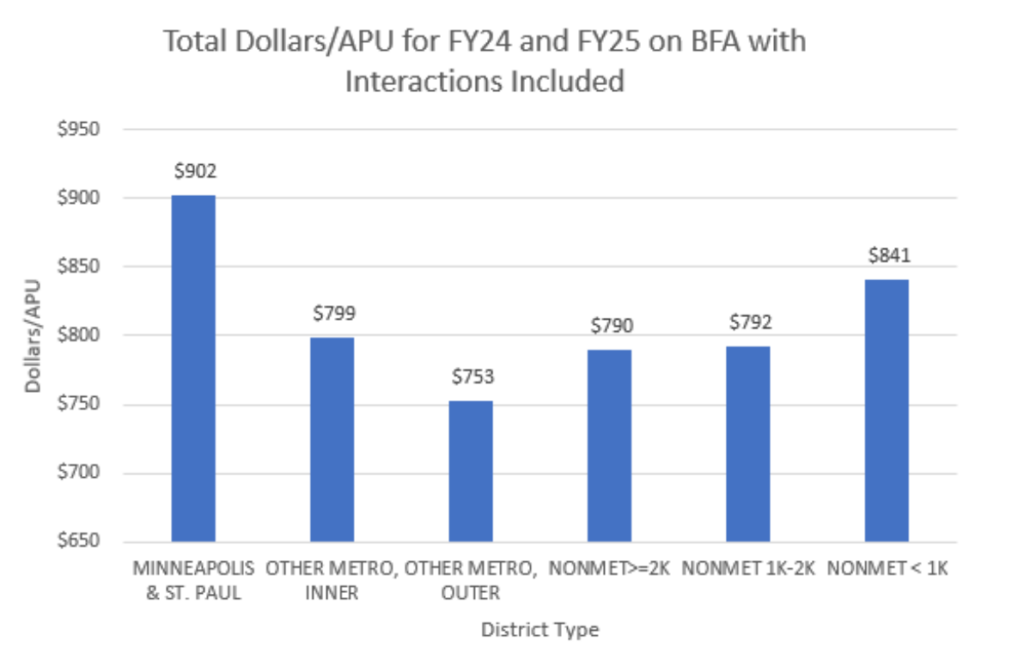Part II – Basic Formula Allowance Increase
In our last article, MREA explored how districts varied in total general education dollars received from the new legislation passed in the 2023 Session. We will now start dissecting the different revenue streams from MDE’s spreadsheet. Today’s article focuses on the Basic Formula Allowance (BFA) and the revenue streams tied to it.
Last September, MREA published an article on the Basic Formula Allowance and the revenue streams tied to it. The article shows how an increase in BFA impacts district funding.
In the 2023 Legislative Session, the legislature passed a 4% BFA increase in FY24 with a 2% BFA increase in FY25. This equates to $275/APU in FY24 and an additional $134/APU in FY25. In total, districts will receive $7,138/APU in FY24 and $7,281/APU in FY25. This number is the same for every district across the state.
The difference in funding between districts comes from the revenue streams attached to the Basic Formula Allowance. Column G and T on the MDE spreadsheet titled “Formula Allowance Interactions” shows the increase in the different revenue streams tied to the formula.
The major revenue streams tied to the BFA are Sparsity, Transportation Sparsity, Declining Enrollment, and Compensatory Revenue. Logically, the districts that receive the different sparsity aids, have high compensatory, and/or are declining in enrollment should see the biggest increase in revenue per APU associated with an increase in the Basic Formula Allowance.
Let’s look at an example with two districts on extreme sides of the BFA funding spectrum:
Minnetonka had one of the lowest per APU increases at $697/APU in their BFA and South Koochiching had one of the highest at $1,381/APU. According to MDE’s FY23 Levy Limitation and Certification report, Minnetonka’s enrollment is projected to remain steady, compensatory is projected at $5.22/APU, they receive no sparsity revenue or transportation sparsity revenue. Conversely, South Koochiching has a slight decline estimated in APU, a higher compensatory of around $739/APU, has over $3,735/APU in Sparsity, and receives around $1,130/APU in Transportation Sparsity. Since each funding stream is tied to the BFA, any percent increase in the BFA will favor South Koochiching over Minnetonka per APU.
MREA’s map that shows the total increase per APU for the 4% and 2% increase in the Basic Formula Allowance and the funding streams tied to the BFA.
MREA Map: Basic Formula Allowance Increase
The median increase in revenue is $805/APU over the two years. Many rural districts did well as it relates to the increase in the BFA. The top 25 districts who received the most per pupil funding on the BFA were small, rural districts.
On the other hand, 18 out of the bottom 25 are in the 7-county metro area. Most of these are districts that surround the metro area are what the state classifies as outer Metro. This makes sense when considering the example above of the two extremes.

When considering the district types in the chart above, Minneapolis and St. Paul receive the most per pupil funding followed by the smaller rural districts. Minneapolis and St. Paul districts have been losing a significant number of students the last couple of years, and their Compensatory Revenue per APU is high. Many of MREA’s rural districts are similar, but also have high Sparsity and Transportation Sparsity Revenues. Districts immediately outside the metro area did not fare as well. Many of these districts are growing and have low compensatory numbers per APU.
Inflationary Index
One of the biggest wins in the 2023 Legislative Session was tying the Basic Formula Allowance to inflation (CPI-U) for FY26 and beyond. Districts will now be able to plan for a minimum of between 2-3% increase on the basic formula allowance. This minimum also leaves room for additional money to be added to the BFA in future legislative sessions. Now a district can budget an increase of between 2–3% each spring and not have to wait for the results of each legislative session to know their revenue increases for the upcoming school year. This ability to budget should bring more stability to Minnesota school districts.
Key Takeaways
- Tying the BFA to inflation will bring more stability to districts and allow them to budget more accurately for the future.
- Putting money on the Basic Formula Allowance is good for every district. All districts will see a $275/APU for FY24 and a $134/APU for FY25 increase because of the new legislation.
- Because of the revenue streams tied to the BFA increase, certain districts receive more or less than others.
- Districts with high Sparsity, Transportation Sparsity, Compensatory or Declining Enrollment receive more per APU than districts who did not have these revenue sources because of a Basic Formula Allowance increase.
Next Up – Special Education and English Learner Cross Subsidy Reduction
In the next Insider Brief, MREA will focus on the Special Education and English Learner Cross Subsidy Reduction funding changes from the 2023 Legislative Session.





